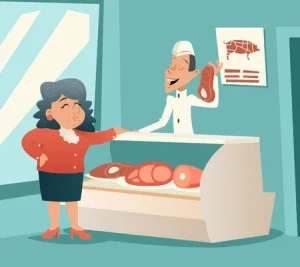CHAPTER 10
STEVE THE BUTCHER
July 1962
After that day in the Panik, I stayed away from the project, the lot, and my so-called friends, but not Steve’s Market. I’d walk with Rib to see Steve and Yolanda almost every day. Steve would give Rib a treat, grab some candy and sodas, and the four of us would sit out in front of his store.
Steve was from Hungary—and despite what Mem said about men, I trusted him, and so did Yolanda. Steve had some weird numbers on his left arm, and when I asked him about it, he said that the numbers were branded on him by some evil and wicked men. When I asked him if it hurt when he got branded, he said it hurt more mentally than physically.
He told Yolanda and me that he was sent to a camp in Poland with his baby brother. Yolanda asked him if his brother also got branded by the bad guys, but he sadly shook his head no. I could see that all the branding and brother talk was too much for him, so I asked Steve how he got into the meat business, which seemed to perk him up.
Two Saturdays ago, after working at Woolworths, Mem got ready to go to Steve’s Market, and I jumped at the chance to go with her—something that puzzled her since I wasn’t big on grocery shopping. But she welcomed the company, so I tagged along while Steve showed her the specials.
He went into a freezer behind the meat case and brought out a huge steak he wanted to show Mem. She was impressed but told Steve she couldn’t afford no steak and bought her usual chopped meat, liver, and hot dogs.
Steve offered her a free Hurka sausage, but she refused and said her usual about not taking charity. He insisted and said the sausage would have to be thrown out if it wasn’t cooked right away. So, Mem, who never threw food out, agreed to take it off his hands, and we had a feast of sausage and onions that night.
Every week is the same old food—hot dogs with baked beans on Monday and Tuesday and liver and onions on Wednesday and Thursday. Mem has a rule that whatever she cooks has to last us two nights, which is tricky because there is barely enough food for one night.
On Fridays, we eat fish. No meat is allowed on Friday nights because it’s against our religion. When I asked Mem why she explained that Jesus sacrificed his flesh for us. I don’t know what His flesh has to do with fish, but every Friday night, we walk over to Joseph and Mary’s on Seaview Avenue and pick up fish and chips. And every single Saturday and Sunday night, we eat hamburger casserole, so Steve, the butcher’s sausage, was a delicious change and a special Saturday night treat.
Last Saturday, after working at Woolworths, Mem did her usual shopping at Steve’s, and I was right there beside her. Steve was helping another customer, but I could see that he was excited to see us.
When it was our turn, he asked Mem if everything was okay with the Hurka sausage. Mem told Steve the sausage was delicious and that she fried it up with some onions. Then Mem turned to me and asked if I thought the sausage was delicious, and I nodded my head yes while wondering where all this sausage talk was going.
“And the hot dogs? How were they?” Steve asked. “Oh, they were good. We had them Monday and Tuesday,” Mem answered. Steve smiled from ear to ear. “And the liver?” “The liver was good too; I cooked it in bacon grease,” she replied. And then Steve said, “Bacon grease gives the liver a real good flavor.”
I thought their conversation about meat and bacon grease was weird, but who cared? Because Mem was talking to a man! That was a first for me, and anyway, Steve is a good guy and knows his meat. My neck was twisting back and forth between the two of them as they yacked away about hot dogs, liver, and Hurka sausage.
“Maybe I could suggest something for tonight?” Steve asked, and Mem replied, “We always eat hamburger casserole on Saturday night.”
“I’ll tell you what,” Steve said to Mem. “I got no family—I eat alone every night. How ‘bout if I bring you over this steak tonight, and I’ll show you how to cook it?” He presented the slab of beef he pulled out of the meat case like it was gold.
My mouth hung wide open, and I whispered, “Mem, please say yes,” while tugging on her dress. Steve was nice, but that steak was something else.
I couldn’t help but notice Steve rubbing the numbers on his branded arm. “I hate to waste a good steak on just me, and I hate eating alone.”
Mem stood there for what seemed like forever. I was still tugging on her dress when she finally said, “Well, okay, but it’s not charity, right? Because Mon Dieu, we won’t take the charity.” Steve assured her that it wasn’t charity, and they made plans for him to come over after he closed up shop.
We hurried home, cleaned up the apartment, sprayed Raid all around the kitchen, baked some potatoes, and steamed the broccoli. Mom was working and always came home late on Saturday nights, so it was just going to be the three of us, which was fine with me because Mom would have made a whole stink about Steve, and I don’t think Mem would have ever had him over if she knew Mom would be home.
Mem didn’t say anything to me, but I could see that she was nervous. I never saw Mem with a man before, so I was happy for her. Mem kept checking herself out in the bedroom mirror and even put on lipstick and rouge! It occurred to me that she probably only had the one boyfriend, who ended up being her jerk of a husband, so I was hoping this would be a good night.
Steve came right on time, and Mem jumped up when he knocked. She straightened her hair, adjusted her false teeth, and smiled the most beautiful smile at me before opening the door.
Without his white butcher jacket with blood stains all over it, Steve fixed up pretty good. And that steak, oh boy!
Mem lit a fire in the broiler at the bottom of the stove, and the two of them talked nonstop about—you guessed it—meat. I didn’t even know we had a broiler!
By the time we all sat down for dinner, they were like old buddies, laughing and gossiping about the local people. Steve warned us to be careful going out at night because the neighborhood was going bad.
Mem replied that the neighborhood was already bad but that we were getting out soon and that she was saving her money for a decent place with a yard. I didn’t care if we had a yard or not, just no bugs and rodents.
After we ate, Steve helped Mem clean up, and when he asked her if he could come back for supper another time, Mem said she would like that. I was wondering what Mom was going to think about all this Steve stuff.
Then he asked her what we were doing on Friday night, and Mem told him we always order fish and chips from Mary and Joseph’s. He asked if it was okay to join us—but only if he could make his famous fish and chips. He told Mem he doesn’t do anything on Friday nights, and in his humble opinion, his fish and chips are way better than Mary and Joseph’s.
Mem reminded him again that “we don’t take the charity from nobody,” and he assured Mem that she was doing him a favor by getting him out of his house. They shook hands and said goodbye.
After that steak dinner, Steve became a big part of our lives, and our meals of chopped meat, hot dogs, and liver were pretty much over.
And Steve was right when he said he made the best fish and chips, so our Friday night pickup from Mary and Joseph’s was also over.
Now, all we had to do was get rid of the snapping traps and shoeboxes, move Mere Germaine back in, and our lives would be perfect.



